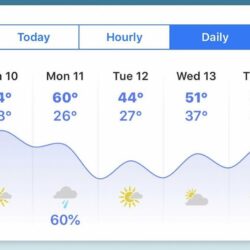“If you don’t like the weather, wait 10 minutes”
They say “if you don’t like the weather in North Texas, wait 10 minutes because, it’s about to change”. This saying can be most accurate during the winter months. It is not uncommon for the temperature to drop 30* in a few hours. The best piece of advice that I received when I first moved to Fort Worth from Phoenix Arizona was from my uncle Owen. He told me to always have a backup of several clothing options in my vehicle at all times. From a light hoodie to a heavy jacket and even a change of socks just in case. I have kept this advice for the last 15 years and it has come in handy countless times. Especially the socks! There is nothing worse than cold wet feet.
The rapid changes in temperatures and the always-evolving weather report, makes it nearly impossible to know what the week or even day holds in store for us. This means a cold front can sneak up on us at any time and temperatures can drop below freezing whether homeowners are ready or not. This makes it imperative for pool owners to keep their swimming pool equipment ready to make it through a freeze, from Halloween to Easter, and sometimes longer!
Although there is never a 100% sure way to protect your swimming pool equipment from natures wrath, there are several things pool owners can do to make sure their equipment is protected as much as reasonably possible through the colder months. Here is a list of things every pool owner should do and keep up through this season.
Keep that pool filter clean:
Many pool owners neglect their pool filter maintenance during the off months. The off-season could arguably be the most important time to keep the pool filter clean. During the summer, we keep the filter nice and clean to keep water flowing, chemicals stirred up in the water and algae out of the pool. During the winter months, we need to keep that water flowing so that it has less opportunity to freeze. If the water flow slows to the point that it actually freezes, the water expands as it turns to ice, pushing outward with great pressure. This can crack anything from the pluming to the filter and even a cast iron header on the pool heater. For this reason, it is a good idea to clean your filter twice a year. Spring and fall, before the swim season and before the freezing season. This will ensure the filter is working optimally during the vital months of the year. During the filter clean, it is also a good idea to have the grids or cartridges inspected and replaced as needed.
Keep the leaves out:
During the fall when “leaf season” starts, we have several weeks of leaves littering the pool. During this time, skimmer baskets can fill up in a matter of minutes. It is crucial to keep the pool clear of leaves, to ensure the skimmers; suction lines and pump do not become clogged. This can cause a stop to the water flow, and if this happens during a freeze, costly damage can follow. Even if you have a pool service company, you will find it advantageous to take a net to your pool, and empty your baskets, if you notice leaves are stacking up around your skimmers. It may take time out of your day, but it may also keep money in your pocket!
If it’s going to freeze, run you system:
It’s always best to run your equipment during freezing weather. It is not impossible for moving water to freeze, but it does make it much harder. Be sure to run all pumps including your water features to keep the water flowing, it is also important to leave the plumbing valves positioned so water can flow through all the pipes. If a valve is left closed, the stagnant water can freeze. During the colder months, many pool owners choose to run their systems at night.
Put your eyes on your pool everyday:
Intentionally looking at your swimming pool and pool equipment on a daily basis is a great habit to get into. This way you can be sure the pool is full of water and running correctly. Water flow can be checked, and pressures noted so you can rest assured your pool equipment is up to par. Many swimming pools are equipped with freeze guards or even automation systems that run the pool pumps during colder temperatures. I must admit that although I do find these useful, I would never fully trust a freeze guard or automation system. The temperature probes or sensors could be out of calibration, broken, or even affected by the sun. For this reason, putting your eyes on the pool to ensure the freeze guard turned the system on is always a good idea.
If you can’t run it, drain it:
It’s not always possible to run the system during a cold spell. Often times pool equipment breaks at the worst possible moment. For this reason, swimming pool equipment manufacturers design their appliances with drain plugs that can be removed to drain the water out of the equipment. Before doing this, a homeowner must be sure their swimming pool equipment is not located at a level lower than the swimming pool. Most pool pumps have one or two drain plugs located at the bottom of the pump on the sides and, or the front of the pool pump. Swimming pool filters have a large drain plug located at the bottom on either the front or back. Swimming pool heaters generally have one or two drain plugs located near the pipes on the header. Once the plugs have been removed, the air relief valve located at the top of the filter should be opened to allow air in, so the water can drain. Remove the pump and chlorinator lids. If you have a salt cell, remove this as well.
I hope this helps you to avoid some of the costly repairs that the freezing temperatures can cause to your pool equipment.
Jason
WaterTex Pools LLC
817-629-1143

